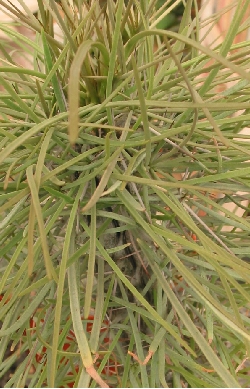Sun Exposure: Young plants should get light shade to part sun.
Origin: Coastal southern Madagascar (Toliara)
Growth Habits: Woody succulent tree, columnar stem up to 16 inches in diameter, up to 20 feet tall (6 m), narrow leaves, up to 6 inches long (15 cm)
Watering Needs: Very little water in winter, regular water while growing. It needs good drainage.
Propagation: Seeds, grafting.
As described in the Bulletin mensuel de la société Linnéene de Paris by M.H. Baillon in 1880
"On the Didierea. - I give this name to a curious plant from Madagascar, observed by M. A. Grandidier, not far from Tulear. The name Grandidiera has been applied to a Bixaceae which can, in my opinion, only constitute a section in the genus Oncoba (see Hist. Of plants, IV, 32). As for Didierea, it will be, I think, the type of a distinct family, because it is not directly related to any of the natural groups that we know, as we will judge by the summary indications which follow.
Imagine a plant that has the port and the consistency of certain cactiform spurges, with a simple or little branched stem, enormous spines spaced apart and arranged in a spiral order, and, above these spines, a cushion bearing, in addition to three other lesser spines (one superior and two lateral), or a group of alternate leaves, linear and glabrous, or a mass of female flowers hanging at the top of small pedicels whose apex swells has a sort of claviform receptacle which carries the perianth. We only know that of the female flower, persistent around the fruit, because D. madagascariensis is dioecious, and its male plants are unknown to us. The perianth (?) Is formed by three alternating pairs of uneven, decussate, membranous leaflets (roses). The inner leaflets are the smallest. Like the medium ones, alternating with them, they are inserted crosswise on the receptacle, while the two outer ones are long falling by their two edges on the receptacle and leave there, when they are removed, long vertical scars. The androceum is only represented here by eight sterile stamens: four superimposed on the four inner leaflets of the perianth, and four, smaller, alternate, all provided with an anther rudiment surmounting a small net. The gynaeceum is free, formed of an ovary with three compartments, like that of the Cashews, two of them remaining sterile and empty surmounted by a columniform style, with very large dilated stiginative head, whose three lobes are spread out, corrugated , finibriés. In the fertile ovarian compartment, there is only one ascending ovum, with outer and lower micropyle.
The trigone fruit recalls that of the Polygonaceaea, dry, not very thick, surmounted by the remains of the style, and. the ascending seed which it contains contains a fleshy embryo whose descending radicle with lower apex is folded over the two fleshy cotyledons."
Fruiting Habits:
5-petaled pinkish-white flower with pink stamens
Desert-Tropicals is dedicated to provide gardening advice, gardening ideas, and information about flower of all kind for landscape and collections.We try to check carefully the identification of the plants on the illustrations as well as the other information from the page, but occasionally errors do occur. if you notice anything that needs to be changed please contact us.Thanks.
© 1998-2020 Philippe Faucon, All Rights Reserved.
